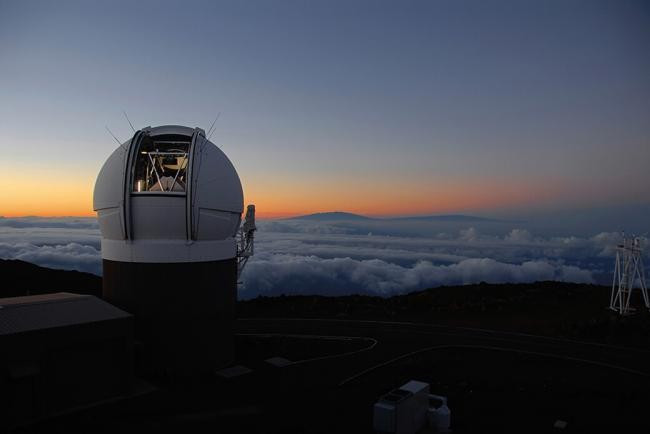



POSITIVE MONEY
Recent Articles


WEAR YOUR MIND AT




Big Brother is
Watching You
Watching You

Click Image to watch the FULL DOCUMENTARY
for Free
for Free



On October 19, 2017, a Canadian astronomer named Robert Weryk was reviewing images captured by a telescope known as Pan-starrs1 when he noticed something strange. The telescope is situated atop Haleakalā, a ten-thousand-foot volcanic peak on the island of Maui, and it scans the sky each night, recording the results with the world’s highest-definition camera. It’s designed to hunt for “near-Earth objects,” which are mostly asteroids whose paths bring them into our planet’s astronomical neighborhood and which travel at an average velocity of some forty thousand miles an hour. The dot of light that caught Weryk’s attention was moving more than four times that speed, at almost two hundred thousand miles per hour.
continues below
continues below
Weryk alerted colleagues, who began tracking the dot from other observatories. The more they looked, the more puzzling its behavior seemed. The object was small, with an area roughly that of a city block. As it tumbled through space, its brightness varied so much—by a factor of ten—that it had to have a very odd shape. Either it was long and skinny, like a cosmic cigar, or flat and round, like a celestial pizza. Instead of swinging around the sun on an elliptical path, it was zipping away more or less in a straight line. The bright dot, astronomers concluded, was something never before seen. It was an “interstellar object”—a visitor from far beyond the solar system that was just passing through. In the dry nomenclature of the International Astronomical Union, it became known as 1I/2017 U1. More evocatively, it was dubbed ‘Oumuamua (pronounced “oh-mooah-mooah”), from the Hawaiian, meaning, roughly, “scout.”
continues below
continues below
Even interstellar objects have to obey the law of gravity, but ‘Oumuamua raced along as if propelled by an extra force. Comets get an added kick thanks to the gases they throw off, which form their signature tails. ‘Oumuamua, though, didn’t have a tail. Nor did the telescopes trained on it find evidence of any of the by-products normally associated with outgassing, like water vapor or dust.
“This is definitely an unusual object,” a video produced by nasa observed. “And, unfortunately, no more new observations of ‘Oumuamua are possible because it’s already too dim and far away.”
As astronomers pored over the data, they excluded one theory after another. ‘Oumuamua’s weird motion couldn’t be accounted for by a collision with another object, or by interactions with the solar wind, or by a phenomenon that’s known, after a nineteenth-century Polish engineer, as the Yarkovsky effect. One group of researchers decided that the best explanation was that 1I/2017 U1 was a “miniature comet” whose tail had gone undetected because of its “unusual chemical composition.” Another group argued that ‘Oumuamua was composed mostly of frozen hydrogen. This hypothesis—a variation on the mini-comet idea—had the advantage of explaining the object’s peculiar shape. By the time it reached our solar system, it had mostly melted away, like an ice cube on the sidewalk.
continues below
“This is definitely an unusual object,” a video produced by nasa observed. “And, unfortunately, no more new observations of ‘Oumuamua are possible because it’s already too dim and far away.”
As astronomers pored over the data, they excluded one theory after another. ‘Oumuamua’s weird motion couldn’t be accounted for by a collision with another object, or by interactions with the solar wind, or by a phenomenon that’s known, after a nineteenth-century Polish engineer, as the Yarkovsky effect. One group of researchers decided that the best explanation was that 1I/2017 U1 was a “miniature comet” whose tail had gone undetected because of its “unusual chemical composition.” Another group argued that ‘Oumuamua was composed mostly of frozen hydrogen. This hypothesis—a variation on the mini-comet idea—had the advantage of explaining the object’s peculiar shape. By the time it reached our solar system, it had mostly melted away, like an ice cube on the sidewalk.
continues below
By far the most spectacular account of 1I/2017 U1 came from Avi Loeb, a Harvard astrophysicist. ‘Oumuamua didn’t behave as an interstellar object would be expected to, Loeb argued, because it wasn’t one. It was the handiwork of an alien civilization.
In an equation-dense paper that appeared in The Astrophysical Journal Letters a year after Weryk’s discovery, Loeb and a Harvard postdoc named Shmuel Bialy proposed that ‘Oumuamua’s “non-gravitational acceleration” was most economically explained by assuming that the object was manufactured. It might be the alien equivalent of an abandoned car, “floating in interstellar space” as “debris.” Or it might be “a fully operational probe” that had been dispatched to our solar system to reconnoitre. The second possibility, Loeb and Bialy suggested, was the more likely, since if the object was just a piece of alien junk, drifting through the galaxy, the odds of our having come across it would be absurdly low. “In contemplating the possibility of an artificial origin, we should keep in mind what Sherlock Holmes said: ‘when you have excluded the impossible, whatever remains, however improbable, must be the truth,’ ” Loeb wrote in a blog post for Scientific American.
Not surprisingly, Loeb and Bialy’s theory received a lot of attention. The story raced around the world almost at the speed of ‘Oumuamua. TV crews crowded into Loeb’s office, at the Harvard-Smithsonian Center for Astrophysics, and showed up at his house. Film companies vied to make a movie of his life. Also not surprisingly, much of the attention was unflattering.
“No, ‘Oumuamua is not an alien spaceship, and the authors of the paper insult honest scientific inquiry to even suggest it,” Paul M. Sutter, an astrophysicist at Ohio State University, wrote.
“Can we talk about how annoying it is that Avi Loeb promotes speculative theories about alien origins of ‘Oumuamua, forcing [the] rest of us to do the scientific gruntwork of walking back these rumors?” Benjamin Weiner, an astronomer at the University of Arizona, tweeted.
In an equation-dense paper that appeared in The Astrophysical Journal Letters a year after Weryk’s discovery, Loeb and a Harvard postdoc named Shmuel Bialy proposed that ‘Oumuamua’s “non-gravitational acceleration” was most economically explained by assuming that the object was manufactured. It might be the alien equivalent of an abandoned car, “floating in interstellar space” as “debris.” Or it might be “a fully operational probe” that had been dispatched to our solar system to reconnoitre. The second possibility, Loeb and Bialy suggested, was the more likely, since if the object was just a piece of alien junk, drifting through the galaxy, the odds of our having come across it would be absurdly low. “In contemplating the possibility of an artificial origin, we should keep in mind what Sherlock Holmes said: ‘when you have excluded the impossible, whatever remains, however improbable, must be the truth,’ ” Loeb wrote in a blog post for Scientific American.
Not surprisingly, Loeb and Bialy’s theory received a lot of attention. The story raced around the world almost at the speed of ‘Oumuamua. TV crews crowded into Loeb’s office, at the Harvard-Smithsonian Center for Astrophysics, and showed up at his house. Film companies vied to make a movie of his life. Also not surprisingly, much of the attention was unflattering.
“No, ‘Oumuamua is not an alien spaceship, and the authors of the paper insult honest scientific inquiry to even suggest it,” Paul M. Sutter, an astrophysicist at Ohio State University, wrote.
“Can we talk about how annoying it is that Avi Loeb promotes speculative theories about alien origins of ‘Oumuamua, forcing [the] rest of us to do the scientific gruntwork of walking back these rumors?” Benjamin Weiner, an astronomer at the University of Arizona, tweeted.
The Military Industrial Complex is today in charge of the US foreign policy, provoking
conflicts in order to export more weapons, just like in Ukraine today. Rafael
The CASH-LANDRUM incidentJames Webb telescope raises hopes for alien life
Classified Alien Encounters Revealed By Traumatologist
Luis Elizondo on unidentified aerial phenomena, extraterrestrials and the Pentagon's UFO programme
ALIEN CHRONICLES (s1 e1)
ALIEN CHRONICLES (S1E2) - DOLORES CANNON - ALIEN
Is There Evidence Of Alien Life Already? UFO Conclusion
ALIEN CONTACT (Episode 1) - ALIEN AND UFO ENCOUNTERS FROM ANOTHER DIMENSION
ALIEN CONTACT (EP2) - ALIEN AND UFO ENCOUNTERS FROM ANOTHER DIMENSION
Alien Case Files:Fast Walkers Alien and UFO Encounters

The Pan-STARRS1 Telescope is located on Halealakalā in Maui, Hawaii.
The dome of the observatory is seen standing open at sunset to prepare for a night of observations.
The dome of the observatory is seen standing open at sunset to prepare for a night of observations.
is the government covering up the truth about extraterrestrials?
alien contact alien and ufo encounters from another dimension